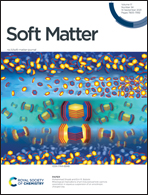Effect of cholesterol on the membrane partitioning dynamics of hepatitis A virus-2B peptide†
Abstract
Understanding viral peptide detection and partitioning and the subsequent host membrane composition-based response is essential for gaining insights into the viral mechanism. Here, we probe the crucial role of the presence of membrane lipid packing defects, depending on the membrane composition, in allowing the viral peptide belonging to C-terminal Hepatitis A Virus-2B (HAV-2B) to detect, attach and subsequently partition into host cell membrane mimics. Using molecular dynamics simulations, we conclusively show that the hydrophobic residues in the viral peptide detect transiently present lipid packing defects, insert themselves into such defects, form anchor points and facilitate the partitioning of the peptide, thereby inducing membrane disruption. We also show that the presence of cholesterol significantly alters such lipid packing defects, both in size and in number, thus mitigating the partitioning of the membrane active viral peptide into cholesterol-rich membranes. Our results are in excellent agreement with previously published experimental data and further explain the role of lipid defects in understanding such data. These results show differential ways in which the presence and absence of cholesterol can alter the permeability of the host membranes to the membrane active peptide component of HAV-2B virus, via lipid packing defects, and can possibly be a part of the general membrane detection mechanism for viroporins.



 Please wait while we load your content...
Please wait while we load your content...